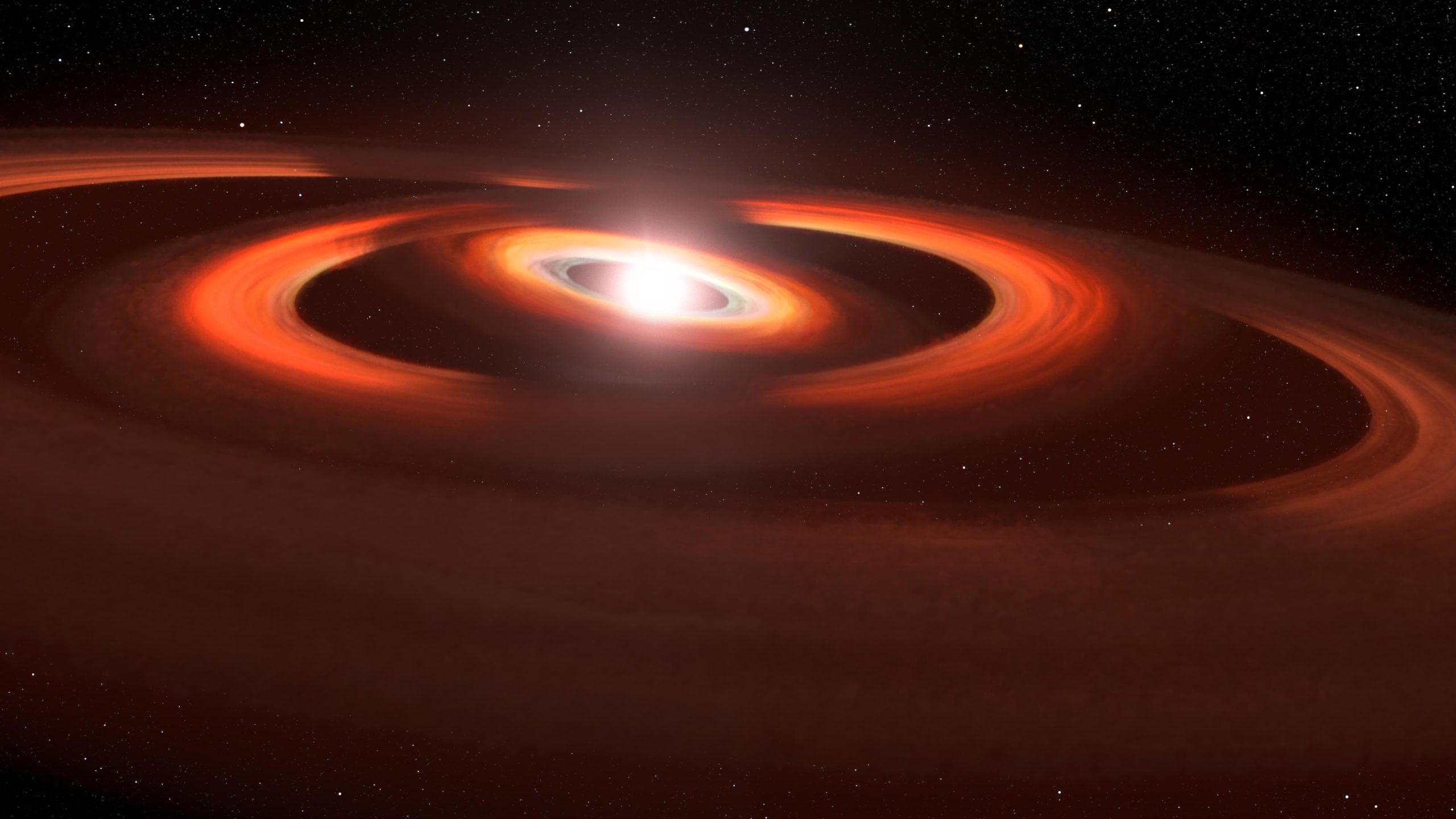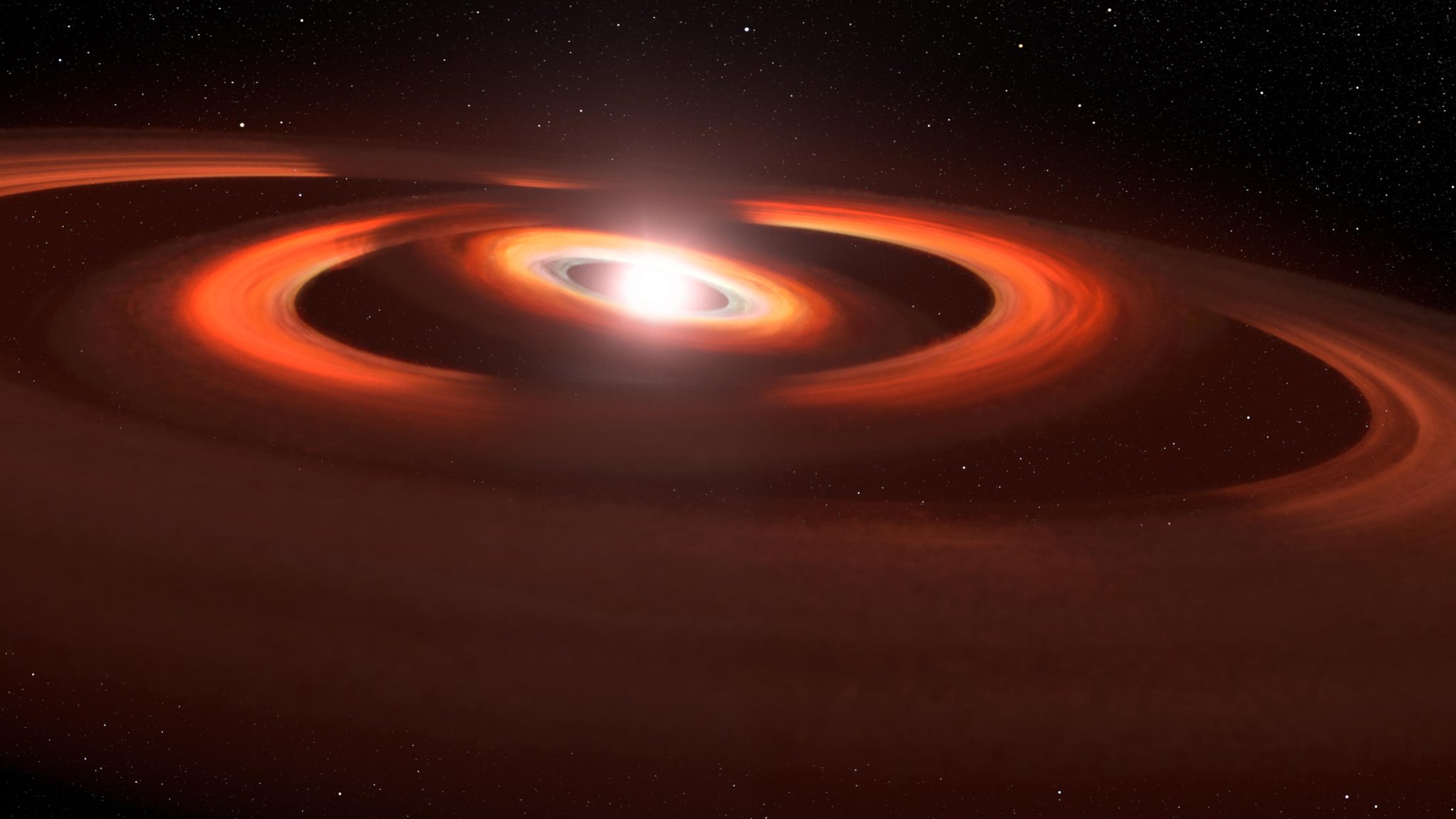

Konsep seniman ini didasarkan pada gambar cakram gas dan debu dari Teleskop Luar Angkasa Hubble di sekitar bintang muda TW Hydrae. Gambar Teleskop Luar Angkasa Hubble menunjukkan bayangan yang menyelimuti piringan yang mengelilingi sistem. Penjelasannya adalah bahwa bayangan ini berasal dari cakram dalam yang agak miring yang mencegah cahaya bintang mencapai cakram luar, sehingga menghasilkan bayangan. Piringan-piringan tersebut agak miring satu sama lain karena gaya gravitasi dari planet-planet tak terlihat yang mendistorsi struktur piringan. Kredit: NASA, Aura/STScI, Badan Antariksa Eropa, Leah Hostack (STScI)
Planet baru lahir yang tak terlihat menimbulkan debu di sekitar bintang muda
Dunia kita sangat berubah-ubah sehingga terkadang suka bermain petak umpet. Pada 2017, para astronom terkejut melihat bayangan besar menutupi piringan debu dan gas yang mengelilingi bintang muda TW Hydrae di dekatnya. Bayangan dilemparkan oleh piringan debu dan gas bagian dalam yang sedikit condong ke bidang piringan luar. Bayangan itu hanya dapat dilihat dengan jelas karena sistemnya dimiringkan berhadap-hadapan di Bumi, memberi para astronom pandangan luas ke piringan saat bayangan melesat di sekitar piringan seperti jarum jam yang bergerak.
Tetapi arloji itu memiliki dua jarum (untuk jam dan menit) yang menyapu dengan kecepatan berbeda. Dan ternyata TW Hydrae juga demikian. Para astronom menggunakan Hubble untuk menemukan bayangan kedua yang muncul dari piringan dalam lainnya, miring ke arah dua piringan luar. Oleh karena itu, sistem tampak semakin kompleks dengan setidaknya tiga cakram yang saling tumpang tindih yang sedikit miring satu sama lain. Disk adalah proksi untuk planet tak terlihat di sekitar bintang. Setiap planet menarik materi di dekat bintang dengan gaya gravitasinya dan mengubah bentuk piringan berbentuk pancake yang rata sempurna jika planet tidak ada. Hal ini tidak mengherankan karena planet-planet di tata surya kita memiliki bidang orbit yang kemiringannya berbeda beberapa derajat satu sama lain. TW Hydrae memberi para astronom tempat duduk di sisi ring untuk melihat seperti apa tata surya kita selama tahun-tahun pembentukannya.

Membandingkan gambar dari Teleskop Luar Angkasa Hubble, yang jaraknya beberapa tahun, telah mengungkap dua bayangan menakutkan yang bergerak berlawanan arah jarum jam melintasi piringan gas dan debu yang mengelilingi bintang muda TW Hydrae. Piringan miring berhadap-hadapan di Bumi, sehingga memberi para astronom pandangan luas tentang apa yang terjadi di sekitar bintang. Foto kiri, diambil pada tahun 2016, hanya menampilkan satu bayangan [A] Sekarang jam 11:00. Bayangan ini dilemparkan oleh piringan dalam yang sedikit condong ke piringan luar dan menghalangi cahaya bintang. Gambar di sebelah kiri menunjukkan bayangan kedua yang muncul dari disk lain yang mengintervensi [C] 07:00, seperti pengambilan gambar tahun 2021. Cakram dalam asli bertanda [B] dalam pertunjukan selanjutnya ini. Bayangan berputar di sekitar bintang dengan kecepatan berbeda seperti searah jarum jam. Mereka adalah bukti dari dua planet tak terlihat yang menarik debu ke orbitnya. Ini membuat mereka sedikit bersandar satu sama lain. Ini adalah gambar cahaya tampak yang diambil dengan Spektroradiometer Pencitraan Teleskop Luar Angkasa. Warna sintetis telah ditambahkan untuk meningkatkan detail. Kredit: NASA, ESA, STScI, John Debes (AURA/STScI untuk ESA), Joseph DePasquale (STScI)
Teleskop Luar Angkasa Hubble mengikuti permainan bayangan di sekitar piringan pembentuk planet
Bintang muda TW Hydrae memainkan “wayang kulit” dengan para ilmuwan mengawasinya[{” attribute=””>NASA’s Hubble Space Telescope.
In 2017, astronomers reported discovering a shadow sweeping across the face of a vast pancake-shaped gas-and-dust disk surrounding the red dwarf star. The shadow isn’t from a planet, but from an inner disk slightly inclined relative to the much larger outer disk – causing it to cast a shadow. One explanation is that an unseen planet’s gravity is pulling dust and gas into the planet’s inclined orbit.
Now, a second shadow – playing a game of peek-a-boo – has emerged in just a few years between observations stored in Hubble’s MAST archive. This could be from yet another disk nestled inside the system. The two disks are likely evidence of a pair of planets under construction.
TW Hydrae is less than 10 million years old and resides about 200 light-years away. In its infancy, our solar system may have resembled the TW Hydrae system, some 4.6 billion years ago. Because the TW Hydrae system is tilted nearly face-on to our view from Earth, it is an optimum target for getting a bull’s-eye-view of a planetary construction yard.
The second shadow was discovered in observations obtained on June 6, 2021, as part of a multi-year program designed to track the shadows in circumstellar disks. John Debes of AURA/STScI for the European Space Agency at the Space Telescope Science Institute in Baltimore, Maryland, compared the TW Hydrae disk to Hubble observations made several years ago.
“We found out that the shadow had done something completely different,” said Debes, who is principal investigator and lead author of the study published in The Astrophysical Journal. “When I first looked at the data, I thought something had gone wrong with the observation because it wasn’t what I was expecting. I was flummoxed at first, and all my collaborators were like: what is going on? We really had to scratch our heads and it took us a while to actually figure out an explanation.”
The best solution the team came up with is that there are two misaligned disks casting shadows. They were so close to each other in the earlier observation they were missed. Over time they’ve now separated and split into two shadows. “We’ve never really seen this before on a protoplanetary disk. It makes the system much more complex than we originally thought,” he said.
The simplest explanation is that the misaligned disks are likely caused by the gravitational pull of two planets in slightly different orbital planes. Hubble is piecing together a holistic view of the architecture of the system.
The disks may be proxies for planets that are lapping each other as they whirl around the star. It’s sort of like spinning two vinyl phonograph records at slightly different speeds. Sometimes labels will match up but then one gets ahead of the other.
“It does suggest that the two planets have to be fairly close to each other. If one was moving much faster than the other, this would have been noticed in earlier observations. It’s like two race cars that are close to each other, but one slowly overtakes and laps the other,” said Debes.
The suspected planets are located in a region roughly the distance of Jupiter from our Sun. And, the shadows complete one rotation around the star about every 15 years – the orbital period that would be expected at that distance from the star.
Also, these two inner disks are inclined about five to seven degrees relative to the plane of the outer disk. This is comparable to the range of orbital inclinations inside our solar system. “This is right in line with typical solar system style architecture,” said Debes.
The outer disk that the shadows are falling on may extend as far as several times the radius of our solar system’s Kuiper belt. This larger disk has a curious gap at twice Pluto’s average distance from the Sun. This might be evidence for a third planet in the system.
Any inner planets would be difficult to detect because their light would be lost in the glare of the star. Also, dust in the system would dim their reflected light. ESA’s Gaia space observatory may be able to measure a wobble in the star if Jupiter-mass planets are tugging on it, but this would take years given the long orbital periods.
The TW Hydrae data are from Hubble’s Space Telescope Imaging Spectrograph. The James Webb Space Telescope’s infrared vision may also be able to show the shadows in more detail.
Reference: “The Surprising Evolution of the Shadow on the TW Hya Disk” by John Debes, Rebecca Nealon, Richard Alexander, Alycia J. Weinberger, Schuyler Grace Wolff, Dean Hines, Joel Kastner, Hannah Jang-Condell, Christophe Pinte, Peter Plavchan and Laurent Pueyo, 4 May 2023, The Astrophysical Journal.
DOI: 10.3847/1538-4357/acbdf1
The Hubble Space Telescope is a project of international cooperation between NASA and ESA. NASA’s Goddard Space Flight Center in Greenbelt, Maryland, manages the telescope. The Space Telescope Science Institute (STScI) in Baltimore conducts Hubble science operations. STScI is operated for NASA by the Association of Universities for Research in Astronomy, in Washington, D.C.

“Geek tv yang sangat menawan. Penjelajah. Penggemar makanan. Penggemar budaya pop yang ramah hipster. Guru zombie seumur hidup.”




/cdn.vox-cdn.com/uploads/chorus_asset/file/24931352/236792_iPhone_15_Pro_and_15_Pro_Max_product_photos_AJohnson_0008.jpg)
More Stories
Jejak kaki dinosaurus yang identik ditemukan di dua benua
Kapan para astronot akan diluncurkan?
Perjalanan seorang miliarder ke luar angkasa “berisiko”